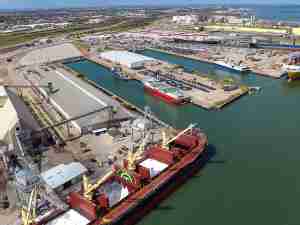Older trucks replaced with newer, cleaner models
The Helen Delich Bentley Port of Baltimore’s Dray Truck Replacement Program, which set a goal to replace 20 existing dray trucks with newer and cleaner models by Earth Day, April 22, 2021, accomplished that goal and, in the process, achieved the most successful quarter ever for replacements since the program began in 2008. Dray trucks are trucks that carry containers to and from the Port of Baltimore.
“Improving air quality around the Port of Baltimore is extremely important,” said MDOT Maryland Port Administration (MDOT MPA) Executive Director William P. Doyle. “Initiatives like the Dray Truck Replacement Program and other environmental programs have proven very effective. We will continue to work closely with our partners at the Maryland Department of the Environment, Maryland Environmental Service and Maryland Energy Administration to make the Port of Baltimore one of the most environmentally-friendly ports in the nation.”
“Dollars For Drays” helps truck owners pay for new trucks and remove older diesel models from service. Qualifying truck owners are offered a rebate of 50% -- up to a maximum of $30,000 – toward the cost of a newer, cleaner truck. Funding comes from the U.S. Environmental Protection Agency’s Diesel Emissions Reduction Act Program, and from Maryland’s Volkswagen mitigation agreement in coordination with the Maryland Department of the Environment (MDE).
“The Port’s dray truck program benefits from involvement at every level, from federal and state agencies to the men and women who drive the trucks serving the Port every day,” said MDOT Secretary Greg Slater. “All of us share a mission of environmental stewardship, and ‘Dollars for Drays’ helps us achieve that goal by taking older equipment off the road and replacing it with cleaner, more efficient models.”
Reaching the Earth Day target of 20 dray truck upgrades means a reduction of more than 6.6 tons of nitrogen oxides and nearly half a ton of fine particulate matter over the lifetime of the replacement trucks. Six additional trucks are scheduled to be replaced in the coming weeks, resulting in additional emission reductions.
The previous record for most dray truck replacement in one quarter was 16 during the second quarter of 2017. To date, 255 trucks have been replaced through this program. In addition, about 100 pieces of diesel cargo-handling equipment such as forklifts, top loaders, locomotives and tugs have been replaced or retrofitted. These efforts have helped lessen air pollution emissions at the Port of Baltimore by 5,100 tons since 2008.
The MDOT MPA, MDE and the Maryland Energy Administration recently renewed and expanded a voluntary Memorandum of Understanding to strengthen environmental initiatives at the Port’s state-owned, public marine terminals. The agreement calls for a continued committed effort to reduce diesel and greenhouse gas emissions and increase energy efficiency at the Port.
The dray truck program is one of many initiatives at the Port contributing to those goals. For instance, the Port’s Dredged Material Management Program uses sediment from shipping channels to restore wetlands and eroding islands. The MDOT MPA recently expanded Poplar Island near Talbot County, adding 575 acres and capacity for 28 million cubic yards of sediment through 2032; and pre-construction and design is underway in partnership with the U.S. Army Corps of Engineers for the Mid-Chesapeake Bay Island Ecosystem Restoration, which will rebuild James and Barren islands in Dorchester County to create habitat and provide shoreline protection.
The MDOT MPA protects stormwater quality through use of an innovative algal flow-way device that removes excess nutrients from Baltimore Harbor, and has performed conservation measures such as helping to restore an eroded stream at the Maryland Zoo in Baltimore, constructing a shoreline at an Anne Arundel County school and partnering with a nonprofit to plant 1,500 trees around Baltimore.
The planned project to expand the 126-year-old Howard Street Tunnel in Baltimore to accommodate double-stacked container trains to and from the Port also has an environmental benefit: Over 30 years, it will help avoid 1.2 billion truck vehicle miles traveled and reduce fuel consumption by an estimated 137 million gallons.










